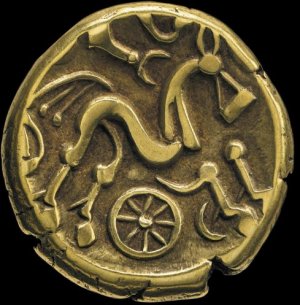A Pagan Connection with the Landscape: Sacred Sites, Symbols, and the Ancient British Terrain.
Below is an old British gold coin, featuring what seems to be a depiction of a horse. A very similar representation can be found carved into the British landscape: the
Uffington White Horse. This ancient figure, created by digging trenches in the hillside and filling them with chalk. It can only be fully appreciated from the air. Compare the hollow shape of the White Horse to the hollow shape on the coin.
The
Uffington White Horse likely held great significance in the ancient world, representing a deep connection to both the land and powerful animals. It comes from a time when people shaped the landscape for different reasons than we do now. A time when people thought they saw patterns in nature, and in the natural shape of the landscape.
Very close by the White Horse are the
Coombes, a natural feature of the landscape, which might have looked surreal to the ancient Britons, and therefore may have held some significance to them. In places they seem to have horizontal lines carved in them.
Nearby is
Dragon Hill, a hill that has been deliberately flattened by the people of the time, possibly for ceremonial reasons. It may have been seen as a sacred place in alignment with the natural Coombes.
To top it off, a couple of hundred yards away, there’s a
Hill Fort (castle) close by too, dug and shaped into the landscape. There are about 1,200 Hill Forts in England alone, and dotted across the country are
burial mounds, and burial structures called
Long Barrows. Perhaps a further testament to the ancient relationship with the land.
It's a bit difficult to dismiss all of this, that would be like dismissing our cultural history along with its past people. Why would anyone want to do that?
The Gold Coin:

3 minute video of the Uffington White Horse and surrounding area:


